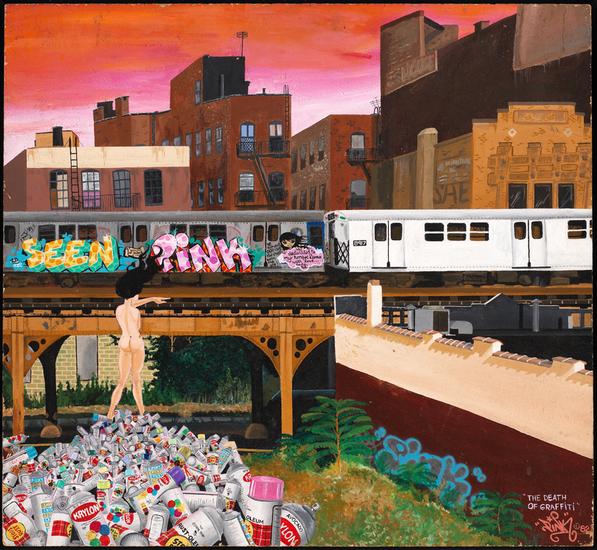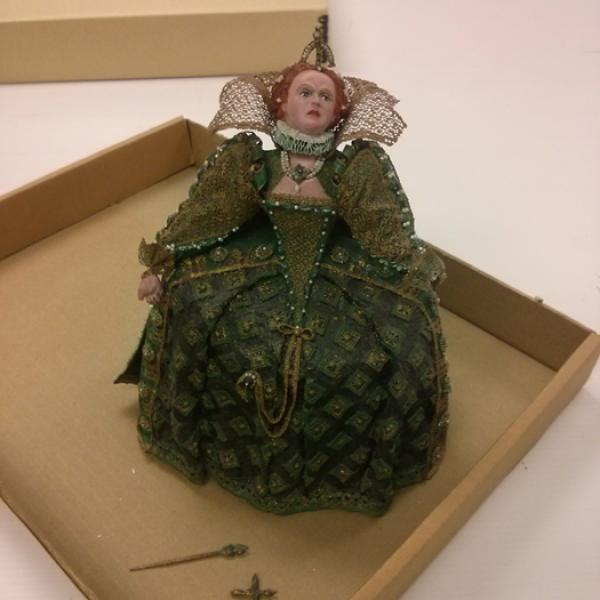Trays, Cavities, and Guillotines
Wednesday, October 11, 2017 by
Here at the Museum of the City of New York, objects are often coming and going. We bring objects in from other cultural institutions as loans to our exhibitions, and we lend objects out as loans for exhibitions all over the world. Most recently, we prepared our exhibition City as Canvas: Art from the Martin Wong Collection to travel to the Indianapolis Museum of Art, where the exhibition opened on October 7.
Whenever art or artifacts travel, there is a registrar somewhere who is charged with insuring its safe passage — this includes not just where it goes, but how it gets there. There are a lot of choices that go into that safety, such as transportation, installation, and insurance, but one of the most fundamental ways to make sure an object is safe is to pack it properly.
There are many different standards and methods for packing art and artifacts. Each institution has their own set of packing specifications that outline how an object needs to be packed in specific situations. Factors such as fragility, size, and distance traveled can all enter the equation. Many travel situations might require a wooden crate with layers of insulating and cushioning foam along with protective barriers for moisture and humidity control. This helps to ensure that the objects are in an environment as close to the regulated museum climate at all times, and different objects all have different packing needs.
For smaller framed objects, a tray pack is usually the standard choice. This packing method uses flat foamcore trays divided with cushioning archival foam to provide stability to the objects while they sit flat in a crate. The trays are custom fitted to each individual object to provide a snug and stable fit, and are stacked in an insulated and cushioned crate to absorb any shocks from transportation.
Tray packing can be very useful for standard sized framed objects, but trays will not work for three-dimensional objects, which need to be supported in many different places from many different angles. The easiest method for that support is a cavity pack. Multiple layers of archival foam are layered together and then carved out to make a custom-shaped pocket the object will sit in. This package is then placed inside an insulated and cushioned crate.
Fine art packers will painstakingly carve away at the foam to turn that pocket into a negative of the object meant to nestle into it. Many fine art craters are sculptors working a day job. The cavity is then lined with a soft, non-abrasive layer to ensure that nothing will rub against the object during travel. Another cushion or a strap can then go over the object to keep it down in the cavity during travel. The strap will be covered in a soft, non-abrasive layer, and depending on the fragility of the object, might even be covered with a non-abrasive archival pillow.
Some three-dimensional objects are either too large or too fragile for a cavity pack. Artwork and artifacts that would not be properly supported by a standard cavity need support that will touch the object in as few places as possible. This can be provided with braces that reach out from the sides of a box or crate to touch the object and support it at the most stable parts. Care is taken to evenly distribute the object’s weight and to make sure that the braces can support it appropriately. As with a cavity pack, the ends of the braces are molded to the part of the object contacted and covered in soft, non-abrasive, archival materials.
These braces will need to be removed in a particular order once the object is ready to come out of its crate. If the object will allow for it, one easy way to do this is to construct a guillotine brace. This is a long brace that contacts the object all the way across and is inserted and removed by sliding in and out on runners. As with other packing methods, this guillotine will be carved away to fit snuggly along the object without applying undo pressure.
Each artwork and artifact is unique with its own packing needs. Packing methods such as tray packs, cavity packs, and braces are all guidelines, but each object needs to be evaluated on an individual level. A team of registrars, curators, conservators, and fine art packers will all consult to determine the best packing method for each object. All of that care and discussion will hopefully lead to safer transport for the object — and fewer sleepless nights for the registrar!




